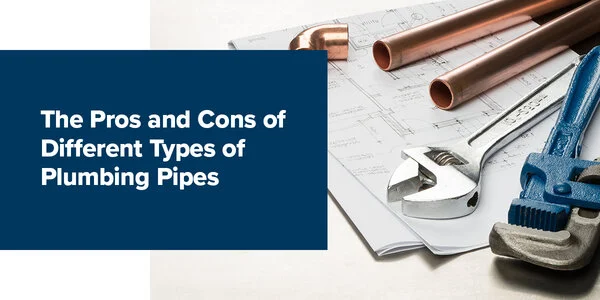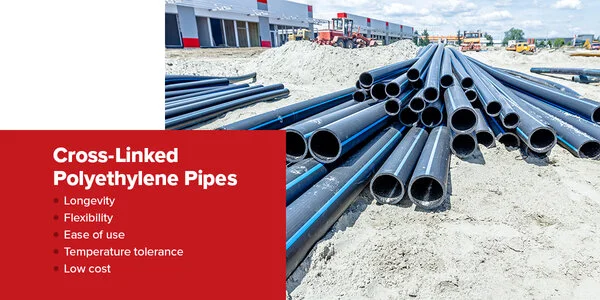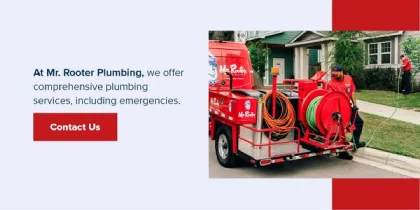
Since the invention of plumbing, the material used for pipes has been of critical importance. Plumbing technology has changed dramatically since the days of lead and clay pipes. Now, there are many types of plumbing pipes available to suit a wide variety of plumbing systems and budgets.
Each water pipe material has its pros and cons. The integrity of your home's plumbing plays an important role in your quality of life, so you need to make a well-informed decision when selecting your piping material.
- Most Common Types of Plumbing Pipes
- Copper Pipes
- Galvanized Steel Pipes
- Polyvinyl Chloride Pipes
- Chlorinated Polyvinyl Chloride
- Cross-Linked Polyethylene Pipes (PEX)
- Stainless Steel Pipes
- Cast Iron Pipes
- Polybutylene Pipes
- High-Density Polybutylene Pipes
- Black Iron Pipes
The Most Common Types of Plumbing Pipes
What are plumbing pipes made of? The answers to this question are almost endless. With so many options to choose from, it can be tough to figure out which material you should choose for your home.
We will break down the different types of water supply pipes to help you decide which is the best piping for plumbing in your home.
1. Copper Pipes
Copper is a traditional material for plumbing pipes and remains a popular option today. There are two main types of copper pipes that can be used together to outfit a whole plumbing system:
- Rigid copper: Rigid copper, sometimes called hard copper, is used throughout a house or building for the water supply. The material can easily be cut into pieces and then soldered together.
- Flexible copper tubing: Flexible or soft, copper is malleable and is used in short runs where space is tight and flexibility is needed, such as in corners or in a supply line to your faucet.
Copper piping comes in different sizes, labeled by the diameter in millimeters, from one outside edge to another. The most popular sizes are 15 mm and 22 mm. You can also get 18 mm piping and many sizes above 22 mm, all the way up to 108 mm.
The other way of measuring rigid copper piping has to do with its thickness. There are three grades of thickness to choose from for use in plumbing:
- Type M: This type is the thinnest copper used in plumbing. It can usually be used for water piping, but it is more often used for drain, waste, and vent (DWV) piping. This type works well for hot and cold supply lines in homes.
- Type L: This medium thickness tends to be the type of choice for transporting drinking water. As with Type M, this type works well for interior hot and cold supply lines.
- Type K: This type has the thickest walls, making it ideal for harsh conditions. Unlike Types M and L, Type K is the ideal choice for underground service lines.
Copper pipes offer significant benefits that have helped them stand the test of time. These benefits include:
- Longevity: Copper is a reliable material that can last at least 50 years.
- Durability: Copper is sturdy and resistant to leakage and corrosion.
- Safety: Bacteria cannot thrive in copper pipes and copper does not pollute water, so it is safe to transport drinking water.
- Recyclability: When copper pipes eventually need to be replaced, the material can be recycled.
- Temperature tolerance: Copper can stand up to extreme temperature changes, including those caused by hot and cold water.
With so many strengths, you may wonder why copper is not used for plumbing in every case. The disadvantages of copper include:
- Financial cost: The main deterrent to using copper is the cost. The value of copper as a global commodity has gone up in recent years — today, it can cost you between $200 and $800 for 100 feet of piping.
- Environmental cost: Environmentally-conscious homeowners may be concerned about the impact of copper mining and manufacturing on the environment. So, although copper pipes last a long time and can be recycled, they are not considered a "green" product.
2. Galvanized Steel Pipes
Galvanized piping used to be the material of choice for residential plumbing and it is still what many people picture when they think of plumbing pipes. The material's main benefits include:
- Corrosion resistance: Galvanized pipes are coated in a layer of zinc, which helps prevent rusting.
- Affordability: While installation can be costly, galvanized steel is a much cheaper material than copper.
- Strength: Like stainless steel, galvanized steel is highly rigid and able to withstand heavy loads.
- Ease of installation: The ends of galvanized steel pipes are threaded, so they can easily screw into each other.
Although these pipes are undoubtedly strong, they are rarely used in new installations. You might have them if your plumbing was installed in the 1980s or before — if this is the case, you should consider replacing them right away. Here are some of the biggest reasons why:
- Short life span: Galvanized steel pipes last about 20 to 50 years before they begin to break down. This life span pales in comparison to that of many other piping materials.
- Rust: While the galvanization process increases rust resistance, it does eventually fail. Rust can build up inside over time and can break loose from the pipe's interior walls, mixing with the water as it flows through. This discolors and contaminates water.
- Lead Contamination: If pipes become corroded, lead can leach into the water and make it unsafe to drink.
- Clogs: Over time, mineral build-up inside galvanized pipes can begin to form clogs that block water flow.
- Weight: While these pipes are sturdy, they are also extremely heavy and difficult to work with.
- Vulnerability: When galvanized pipes are damaged, the galvanization on the outside is compromised, which makes the pipe vulnerable to corrosion in a short amount of time.
3. Polyvinyl Chloride Pipes
Polyvinyl chloride (PVC) is growing in popularity among homeowners. PVC is a thermoplastic polymer, a combination of vinyl and plastic that softens at high temperatures. At normal temperatures, PVC pipes are rigid.
Usually, they are either cream, white, or gray, but you can also find them in almost any color you like. PVC is most often used for transporting highly pressurized water, like what you would find in your home's main water supply line. However, PVC is versatile and useful for a variety of applications, such as draining and potable water transport.
Depending on the application, you can choose a particular thickness and configuration designed to best support that application. If the piping is meant to transport drinking water, look for an "NSF-PW" or "NSF-61" label, which means the material meets the standards laid out by NSF/ANSI 61.
Some of the benefits of PVC pipes include:
- Longevity: Because PVC is plastic, it is naturally rust and corrosion-resistant. Unless it gets damaged, it can last for generations. PVC can last even longer than steel or copper, which are some of the most durable metals for plumbing pipes.
- Ability to handle pressure: PVC can withstand high water pressure, which makes it an excellent choice for the main supply line in your home.
- Ease of use: Compared to metal pipes, PVC is extremely lightweight. As a result, it is easy to transport and work with. Its simple connection also makes installation easy — rather than soldering the pipes together, installers connect them with glue.
- Affordability: PVC is also relatively inexpensive, especially when compared to copper, making it a cost-effective option for plumbing pipes.
While PVC has some marked advantages, it has a couple of disadvantages, too. These include:
- Susceptibility to warping: PVC is not equipped to transport hot water because, like other thermoplastics, PVC can warp and melt when in contact with heat.
- Size: There are a few sizing options for PVC pipes, which can be an issue if you have specific size requirements. Even if your PVC piping is the perfect size, the fittings that connect the pipes may be too bulky for tight spaces.
4. Chlorinated Polyvinyl Chloride Pipes
Chlorinated Polyvinyl Chloride (CPVC) is closely related to PVC. Though both materials contain the same basic elements, the key difference is that CPVC is chlorinated. This chemical difference makes CPVC able to withstand temperature differences in a way that PVC cannot. For this reason, some building codes call for CPVC in place of PVC for transporting hot water.
While PVC typically only uses a sizing system called nominal pipe size (NPS), CPVC uses both NPS and copper tubing size (CTS). As the name suggests, this sizing system is similar to the copper piping size graduations.
CPVC pipes share many of the advantages of PVC, plus one more:
- Longevity: Like PVC, CPVC is a plastic material that does not react to corrosive substances or rust. Its life span is indefinite.
- Ability to withstand pressure: CPVC shares PVC's ability to handle high water pressure, making it a good material for a main water supply line.
- Ease of use: CPVC is lightweight and somewhat flexible, which makes it easy to move and work with.
- Low cost: Though CPVC costs more than PVC, it is still a budget option compared to metal piping materials.
- Temperature tolerance: Unlike PVC, CPVC can withstand extreme temperatures up to 200 degrees Fahrenheit.
While CPVC is not always the best choice for some applications, it has relatively few disadvantages. Cons include:
- Indoor application only: CPVC is vulnerable to breaking down if exposed to sunlight for extended periods of time.
- Cost: Though cost is an advantage of CPVC, it still costs more than PVC.

5. Cross-Linked Polyethylene Pipes
Cross-Linked Polyethylene (PEX) is another plastic material used for piping. Plastic pipes have become a popular choice for new homes. This particular plastic material is relatively new on the plumbing scene and can be used for a variety of plumbing applications. The major difference between PVC and PEX is that PEX pipes are flexible. This means they can be used in long, continuous runs.
In addition to being flexible, PEX is easy to cut and join together. The PEX system is designed to fit together through the combination of barbed fittings and crimping rings or cinch clamps. This method of joining pipes is in lieu of any soldering or gluing. The installation process is quick and easy and the material is made to last. PEX piping can come coiled up in a flexible roll, wrapped in aluminum to keep its shape or in hard lengths.
This material comes with some major advantages for plumbers and homeowners that contribute to its rising popularity. These advantages include:
- Longevity: PEX pipes are completely rust and corrosion-resistant. This means they can last indefinitely without needing to be replaced unless they are broken.
- Flexibility: PEX is flexible enough to make 90-degree turns with no problem. It's great for retrofitting and is able to extend across the length of a house with just one long piece.
- Ease of use: PEX's flexibility makes it easy to install. When joints are needed, no soldering or even gluing is required.
- Temperature tolerance: Unlike PVC, PEX can withstand extreme temperatures. It can be used to transport both hot and cold water.
- Low cost: While PEX is more expensive than PVC, it is still significantly cheaper than copper.
While PEX has many advantages, there are some drawbacks:
- Indoor application only: UV radiation can damage PEX piping, making it unsuitable for outdoor use.
- Water taste and odor: Some types of PEX pipes have been known to affect the taste and smell of drinking water, especially if the water has stayed in the pipes for some time.
6. Stainless Steel Pipes
Stainless steel piping is actually more expensive than copper piping. However, its high price point correlates to a high level of quality. Stainless steel pipes are strong and corrosion-resistant. Because of their ability to resist corrosion, stainless steel pipes are the preferable choice in areas that are susceptible to it, such as coastal communities.
Stainless steel piping is available in both flexible and rigid versions and it comes in a variety of sizes. Pipes are fitted together using couplings.
7. Cast Iron Pipes
Cast iron used to be a common piping material for drainage systems, particularly in the first half of the twentieth century, and it can still be found in many homes today. Cast iron is extremely strong, durable, and heavy. Cast iron also reduces sound and is heat-resistant.
Despite the advantages of strength and durability, cast iron is susceptible to rust over time. In homes that have cast iron piping, if a pipe rusts all the way through, you can replace it with plastic piping like PVC. Cast iron pipes come in various sizes, with the smallest usually being 4 inches.
8. Polybutylene Pipes
Polybutylene (PB) pipes were a popular choice for plumbing from the late 1970s to the mid-1990s. In fact, as many as 10 million homes built during that timeframe included polybutylene piping of some kind. Polybutylene is a type of plastic resin that was seen as a futuristic material, perfect for replacing copper.
These grey plastic pipes were, and are, inexpensive and easy to work with. However, they fell out of favor because it was determined that PB pipes were prone to leakage at the joints.
9. High-Density Polybutylene Pipes
High-density polybutylene pipes (HDPE) are one of the most popular choices for underground service lines, though they work in a variety of plumbing applications. This is due to HDPE's durability and ability to resist corrosion.
Some codes call for buried plastic lines to be made from HDPE instead of PVC. HDPE pipes are flexible, so they require minimal joints. Where they do require joints, heat fusion is used, making these pipes mostly leak-proof.
10. Black Iron Pipes
While black iron is not intended for plumbing applications, it is worth mentioning. Black iron pipes were once a popular piping material for water supply, but today, they are only used for conveying natural gas or propane. Black iron is also a popular choice for fire sprinkler systems since it is especially effective at resisting extreme heat.

Choose Mr. Rooter of Greater Syracuse for New York Plumbing Services
Whether you need to install a whole new plumbing system in your home or only need a few repairs, you can trust Mr. Rooter Plumbing of Greater Syracuse to provide the best service possible. At Mr. Rooter Plumbing, we offer comprehensive plumbing services, including emergencies. Call us for fast, courteous, and efficient service, no matter the issue.
Throughout the many years that we have provided the Syracuse community with piping and plumbing services, we have demonstrated a strong commitment to excellent customer service. Contact us today for all your piping and plumbing needs!
Not local to the Greater Syracuse area? Find a Mr. Rooter Plumbing expert near you.

